Applied Business Finance Report: Financial Statement Analysis, Ratios
VerifiedAdded on 2022/01/15
|19
|3093
|290
Report
AI Summary
This report delves into the core concepts of financial management, emphasizing its significance in achieving organizational objectives. It provides a detailed explanation of the main financial statements, including the income statement, balance sheet, cash flow statement, and statement of retained earnings, and explains the use of financial ratios in analyzing a company's performance. The report also demonstrates the application of these concepts through a case study, including the creation of an income statement and balance sheet using Excel, and the analysis of profitability, liquidity, and efficiency ratios. Finally, it discusses processes businesses can implement to improve their financial performance, providing a comprehensive overview of financial management principles and their practical application. The report incorporates calculations and data analysis from a provided case study, illustrating the practical application of financial management tools.
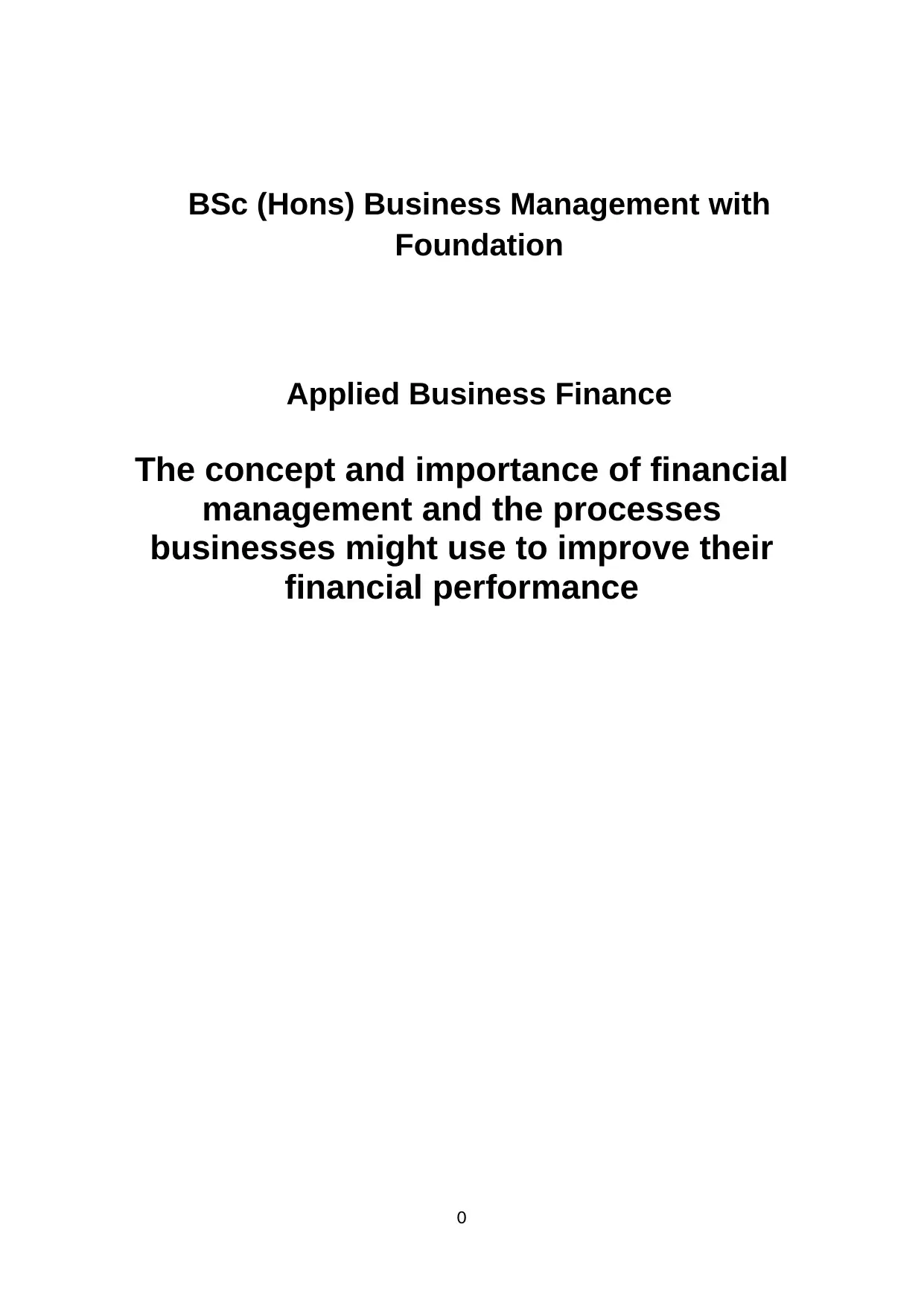
BSc (Hons) Business Management with
Foundation
Applied Business Finance
The concept and importance of financial
management and the processes
businesses might use to improve their
financial performance
0
Foundation
Applied Business Finance
The concept and importance of financial
management and the processes
businesses might use to improve their
financial performance
0
Paraphrase This Document
Need a fresh take? Get an instant paraphrase of this document with our AI Paraphraser

Contents
Introduction p 3
Section 1: Definition and discussion of the concept and
importance of financial management p 3
Section 2: Description and discussion of the main
financial statements and explain the use of ratios in
financial management
p 4-10
Section 3: Using the template provided 10-11
i. Completing the Information on the ‘Business Review Template
(Ensure that you display your calculations for this detail)
P 16
ii. Using Excel producing an Income Statement for the Sample
Organisation (see Case Study). This should be included within
your appendices p 14
iii. Using Excel completing the Balance Sheet p 15
iv. Using the Case study information describing the profitability,
liquidity and efficiency of the company based on the results of
ratio analysis p 10-11
Section 4: Using examples from the case study describing
and discussing the processes this business might use to
improve their financial performance p 11
Conclusion p 12
References p 13-14
Appendix p 15-19
1
Introduction p 3
Section 1: Definition and discussion of the concept and
importance of financial management p 3
Section 2: Description and discussion of the main
financial statements and explain the use of ratios in
financial management
p 4-10
Section 3: Using the template provided 10-11
i. Completing the Information on the ‘Business Review Template
(Ensure that you display your calculations for this detail)
P 16
ii. Using Excel producing an Income Statement for the Sample
Organisation (see Case Study). This should be included within
your appendices p 14
iii. Using Excel completing the Balance Sheet p 15
iv. Using the Case study information describing the profitability,
liquidity and efficiency of the company based on the results of
ratio analysis p 10-11
Section 4: Using examples from the case study describing
and discussing the processes this business might use to
improve their financial performance p 11
Conclusion p 12
References p 13-14
Appendix p 15-19
1
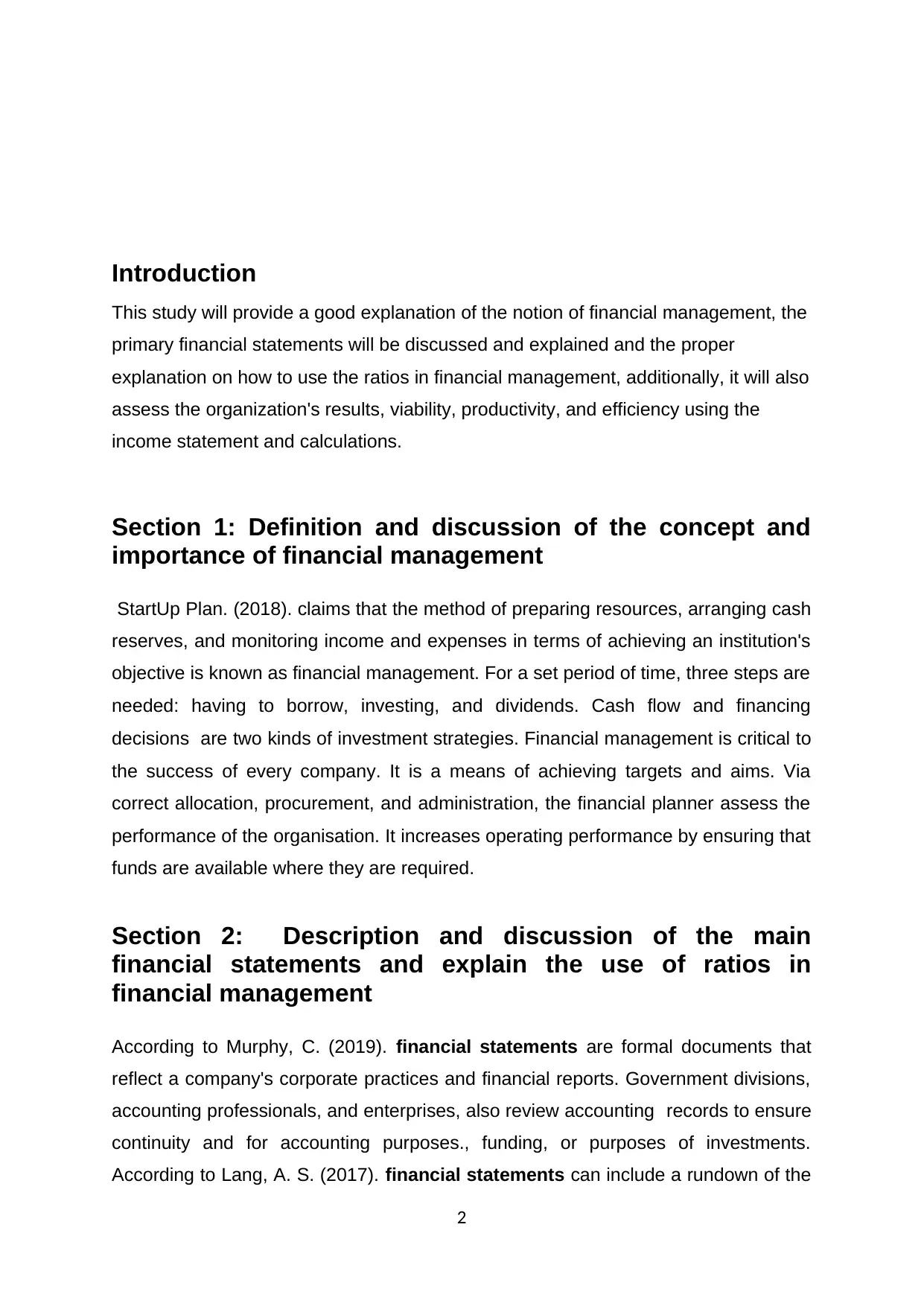
Introduction
This study will provide a good explanation of the notion of financial management, the
primary financial statements will be discussed and explained and the proper
explanation on how to use the ratios in financial management, additionally, it will also
assess the organization's results, viability, productivity, and efficiency using the
income statement and calculations.
Section 1: Definition and discussion of the concept and
importance of financial management
StartUp Plan. (2018). claims that the method of preparing resources, arranging cash
reserves, and monitoring income and expenses in terms of achieving an institution's
objective is known as financial management. For a set period of time, three steps are
needed: having to borrow, investing, and dividends. Cash flow and financing
decisions are two kinds of investment strategies. Financial management is critical to
the success of every company. It is a means of achieving targets and aims. Via
correct allocation, procurement, and administration, the financial planner assess the
performance of the organisation. It increases operating performance by ensuring that
funds are available where they are required.
Section 2: Description and discussion of the main
financial statements and explain the use of ratios in
financial management
According to Murphy, C. (2019). financial statements are formal documents that
reflect a company's corporate practices and financial reports. Government divisions,
accounting professionals, and enterprises, also review accounting records to ensure
continuity and for accounting purposes., funding, or purposes of investments.
According to Lang, A. S. (2017). financial statements can include a rundown of the
2
This study will provide a good explanation of the notion of financial management, the
primary financial statements will be discussed and explained and the proper
explanation on how to use the ratios in financial management, additionally, it will also
assess the organization's results, viability, productivity, and efficiency using the
income statement and calculations.
Section 1: Definition and discussion of the concept and
importance of financial management
StartUp Plan. (2018). claims that the method of preparing resources, arranging cash
reserves, and monitoring income and expenses in terms of achieving an institution's
objective is known as financial management. For a set period of time, three steps are
needed: having to borrow, investing, and dividends. Cash flow and financing
decisions are two kinds of investment strategies. Financial management is critical to
the success of every company. It is a means of achieving targets and aims. Via
correct allocation, procurement, and administration, the financial planner assess the
performance of the organisation. It increases operating performance by ensuring that
funds are available where they are required.
Section 2: Description and discussion of the main
financial statements and explain the use of ratios in
financial management
According to Murphy, C. (2019). financial statements are formal documents that
reflect a company's corporate practices and financial reports. Government divisions,
accounting professionals, and enterprises, also review accounting records to ensure
continuity and for accounting purposes., funding, or purposes of investments.
According to Lang, A. S. (2017). financial statements can include a rundown of the
2
⊘ This is a preview!⊘
Do you want full access?
Subscribe today to unlock all pages.

Trusted by 1+ million students worldwide
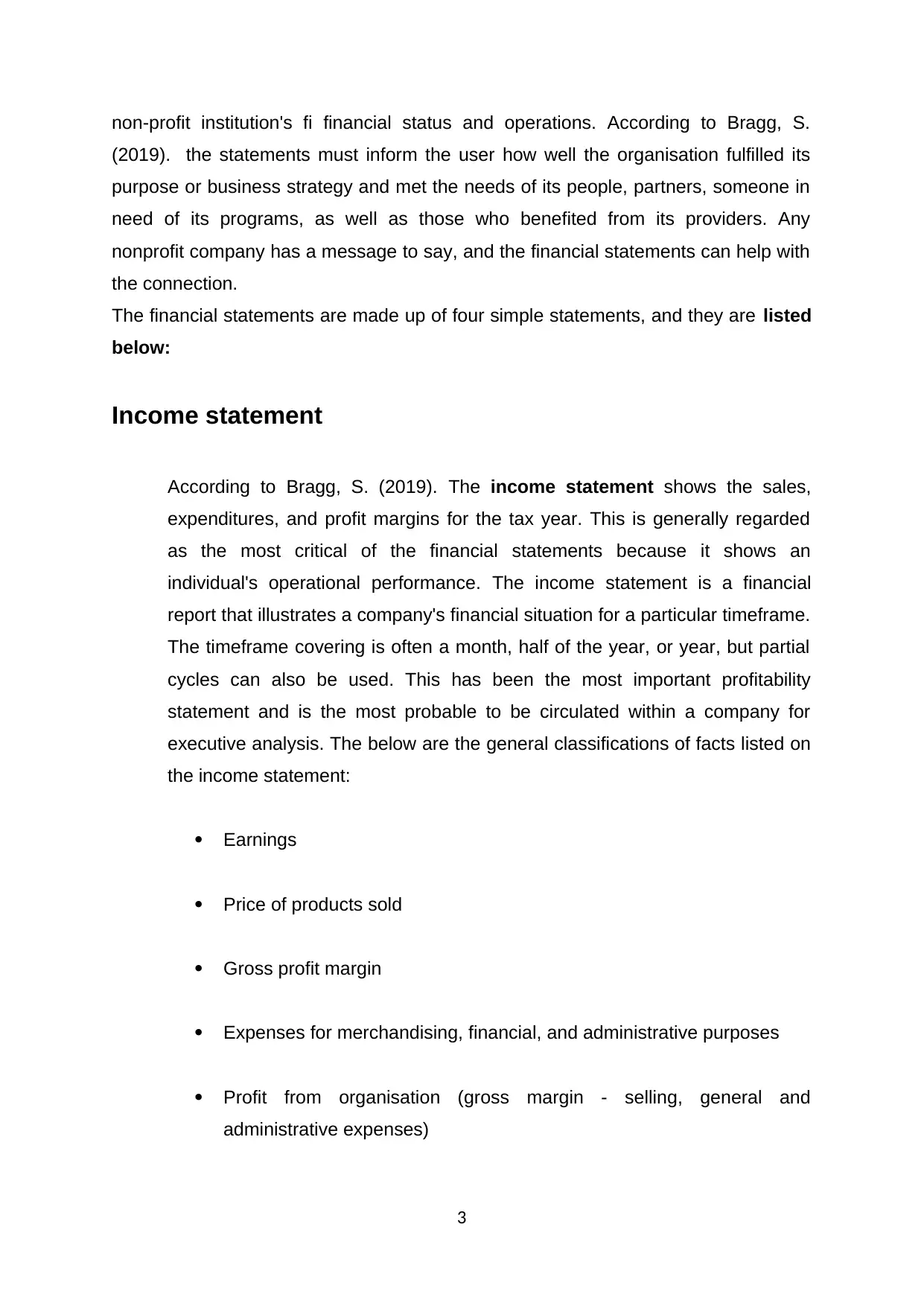
non-profit institution's fi financial status and operations. According to Bragg, S.
(2019). the statements must inform the user how well the organisation fulfilled its
purpose or business strategy and met the needs of its people, partners, someone in
need of its programs, as well as those who benefited from its providers. Any
nonprofit company has a message to say, and the financial statements can help with
the connection.
The financial statements are made up of four simple statements, and they are listed
below:
Income statement
According to Bragg, S. (2019). The income statement shows the sales,
expenditures, and profit margins for the tax year. This is generally regarded
as the most critical of the financial statements because it shows an
individual's operational performance. The income statement is a financial
report that illustrates a company's financial situation for a particular timeframe.
The timeframe covering is often a month, half of the year, or year, but partial
cycles can also be used. This has been the most important profitability
statement and is the most probable to be circulated within a company for
executive analysis. The below are the general classifications of facts listed on
the income statement:
Earnings
Price of products sold
Gross profit margin
Expenses for merchandising, financial, and administrative purposes
Profit from organisation (gross margin - selling, general and
administrative expenses)
3
(2019). the statements must inform the user how well the organisation fulfilled its
purpose or business strategy and met the needs of its people, partners, someone in
need of its programs, as well as those who benefited from its providers. Any
nonprofit company has a message to say, and the financial statements can help with
the connection.
The financial statements are made up of four simple statements, and they are listed
below:
Income statement
According to Bragg, S. (2019). The income statement shows the sales,
expenditures, and profit margins for the tax year. This is generally regarded
as the most critical of the financial statements because it shows an
individual's operational performance. The income statement is a financial
report that illustrates a company's financial situation for a particular timeframe.
The timeframe covering is often a month, half of the year, or year, but partial
cycles can also be used. This has been the most important profitability
statement and is the most probable to be circulated within a company for
executive analysis. The below are the general classifications of facts listed on
the income statement:
Earnings
Price of products sold
Gross profit margin
Expenses for merchandising, financial, and administrative purposes
Profit from organisation (gross margin - selling, general and
administrative expenses)
3
Paraphrase This Document
Need a fresh take? Get an instant paraphrase of this document with our AI Paraphraser

Other revenue and expenses
Taxes on earnings
Net profit or loss
Balance sheet
According to Bragg, S. (2019). the balance sheet is a statement that
describes an organization's assets, liabilities, and resources at a certain
moment in due course. It is commonly used among shareholders, customers,
and stakeholders to measure a company's financial position. Most of the
records utilised with an accounting framework are the balance sheet. The
balance sheet is reported at the close of the fiscal quarter, although the
income statement and cash flow statements are stated for the full fiscal
quarter. The balance sheet displays the amount of the assets, liabilities, and
capital as of the end of the reporting period. As a result, the material given is
current as of a certain period at the moment. The layout of the statement is
designed so that the sum of all capital gains the sum of all liabilities and
equity. This is generally regarded as the second most critical financial
statement because it offers details about an institution's flexibility and capital
requirements. (Bragg, S. 2019).
The following are examples of balance sheet line items (by general category):
Assets: they include cash, commercially viable shares, accrued expenditures,
receivables, stock, and fixed assets.
Liabilities: Accounts receivable, accrued expenses, consumer accruals,
income taxes, short-term debts, and long-term loans
Shareholder equity: inventory, extra paid-in assets, working capital, and
surplus assets.
4
Taxes on earnings
Net profit or loss
Balance sheet
According to Bragg, S. (2019). the balance sheet is a statement that
describes an organization's assets, liabilities, and resources at a certain
moment in due course. It is commonly used among shareholders, customers,
and stakeholders to measure a company's financial position. Most of the
records utilised with an accounting framework are the balance sheet. The
balance sheet is reported at the close of the fiscal quarter, although the
income statement and cash flow statements are stated for the full fiscal
quarter. The balance sheet displays the amount of the assets, liabilities, and
capital as of the end of the reporting period. As a result, the material given is
current as of a certain period at the moment. The layout of the statement is
designed so that the sum of all capital gains the sum of all liabilities and
equity. This is generally regarded as the second most critical financial
statement because it offers details about an institution's flexibility and capital
requirements. (Bragg, S. 2019).
The following are examples of balance sheet line items (by general category):
Assets: they include cash, commercially viable shares, accrued expenditures,
receivables, stock, and fixed assets.
Liabilities: Accounts receivable, accrued expenses, consumer accruals,
income taxes, short-term debts, and long-term loans
Shareholder equity: inventory, extra paid-in assets, working capital, and
surplus assets.
4
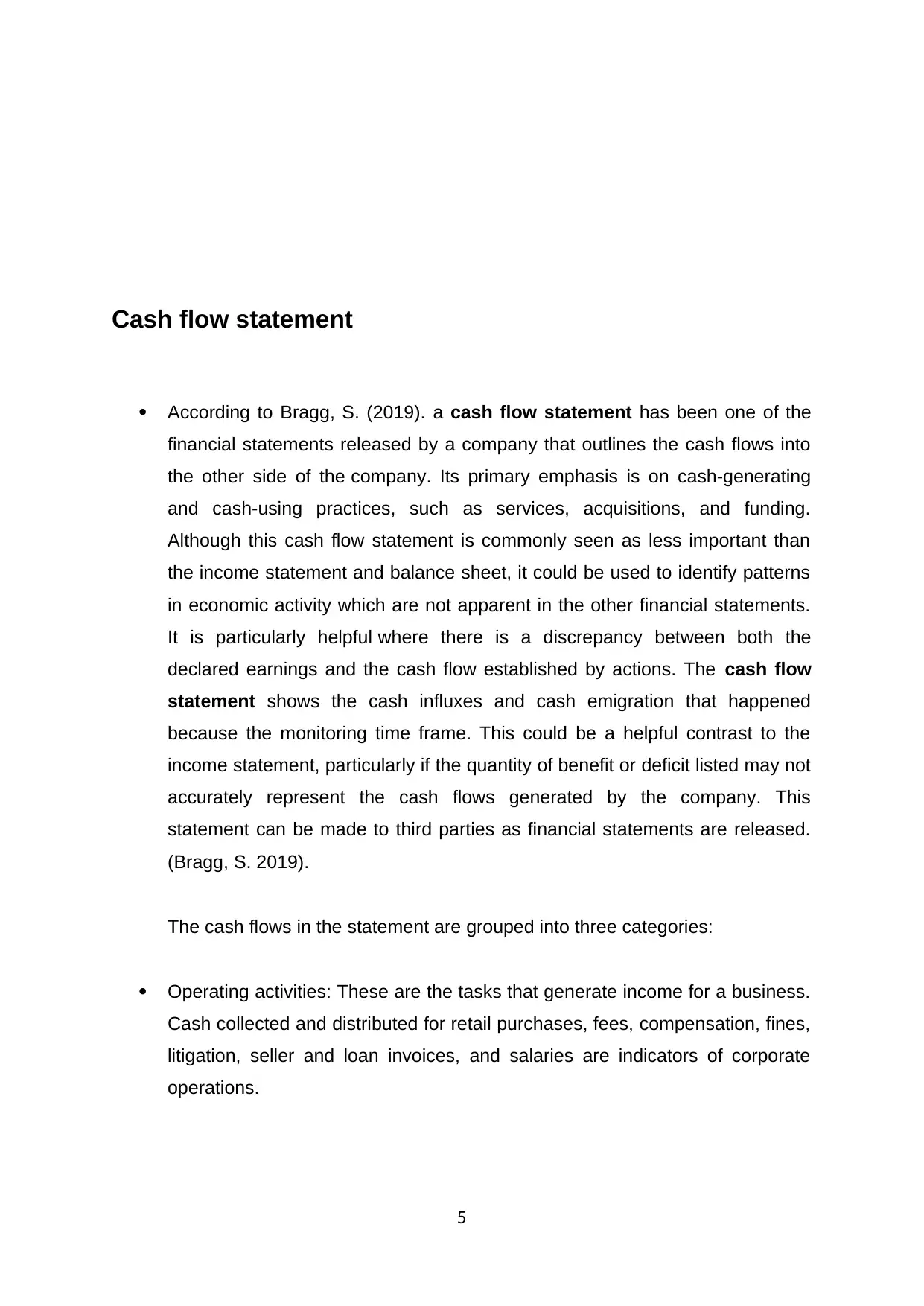
Cash flow statement
According to Bragg, S. (2019). a cash flow statement has been one of the
financial statements released by a company that outlines the cash flows into
the other side of the company. Its primary emphasis is on cash-generating
and cash-using practices, such as services, acquisitions, and funding.
Although this cash flow statement is commonly seen as less important than
the income statement and balance sheet, it could be used to identify patterns
in economic activity which are not apparent in the other financial statements.
It is particularly helpful where there is a discrepancy between both the
declared earnings and the cash flow established by actions. The cash flow
statement shows the cash influxes and cash emigration that happened
because the monitoring time frame. This could be a helpful contrast to the
income statement, particularly if the quantity of benefit or deficit listed may not
accurately represent the cash flows generated by the company. This
statement can be made to third parties as financial statements are released.
(Bragg, S. 2019).
The cash flows in the statement are grouped into three categories:
Operating activities: These are the tasks that generate income for a business.
Cash collected and distributed for retail purchases, fees, compensation, fines,
litigation, seller and loan invoices, and salaries are indicators of corporate
operations.
5
According to Bragg, S. (2019). a cash flow statement has been one of the
financial statements released by a company that outlines the cash flows into
the other side of the company. Its primary emphasis is on cash-generating
and cash-using practices, such as services, acquisitions, and funding.
Although this cash flow statement is commonly seen as less important than
the income statement and balance sheet, it could be used to identify patterns
in economic activity which are not apparent in the other financial statements.
It is particularly helpful where there is a discrepancy between both the
declared earnings and the cash flow established by actions. The cash flow
statement shows the cash influxes and cash emigration that happened
because the monitoring time frame. This could be a helpful contrast to the
income statement, particularly if the quantity of benefit or deficit listed may not
accurately represent the cash flows generated by the company. This
statement can be made to third parties as financial statements are released.
(Bragg, S. 2019).
The cash flows in the statement are grouped into three categories:
Operating activities: These are the tasks that generate income for a business.
Cash collected and distributed for retail purchases, fees, compensation, fines,
litigation, seller and loan invoices, and salaries are indicators of corporate
operations.
5
⊘ This is a preview!⊘
Do you want full access?
Subscribe today to unlock all pages.

Trusted by 1+ million students worldwide
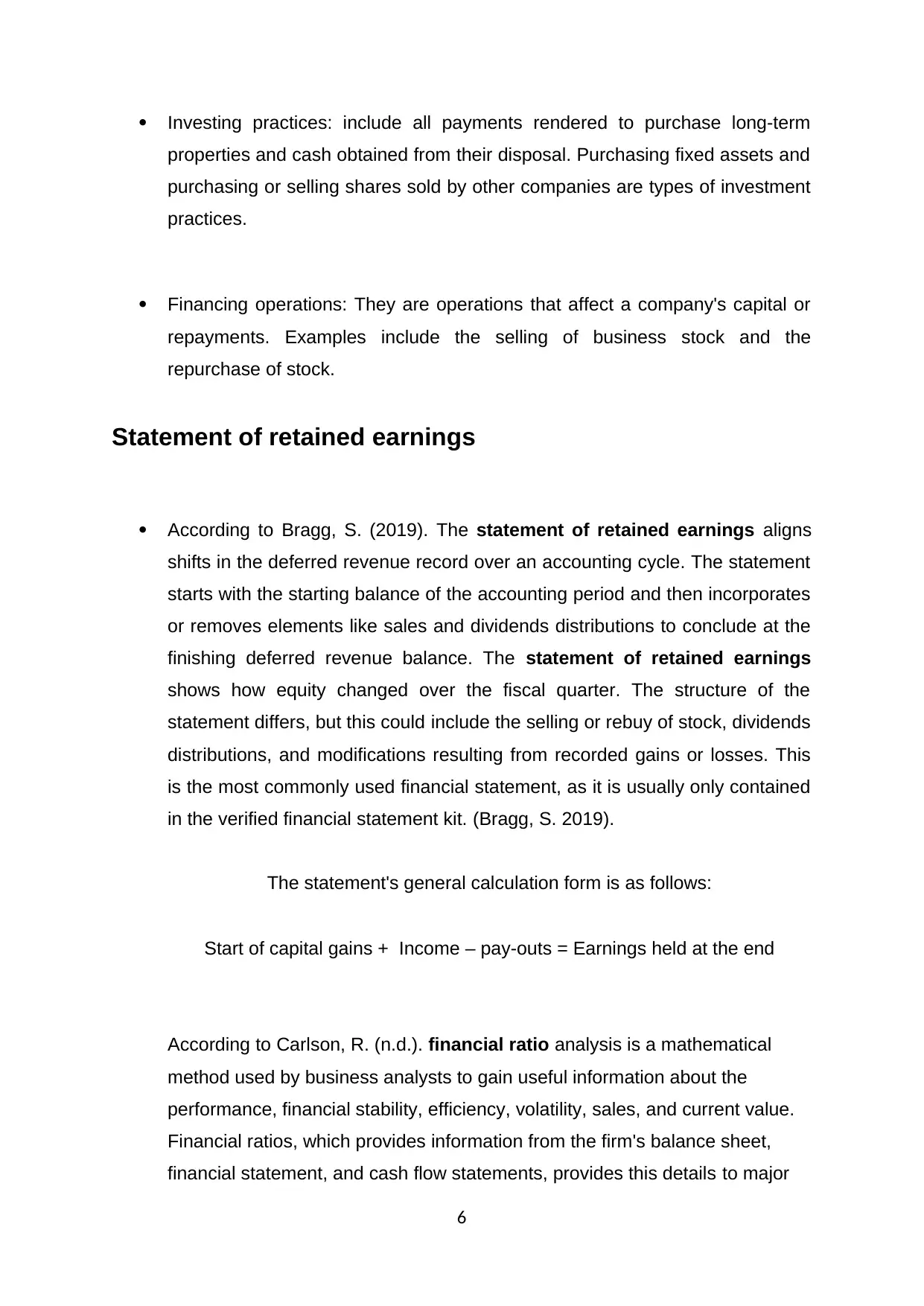
Investing practices: include all payments rendered to purchase long-term
properties and cash obtained from their disposal. Purchasing fixed assets and
purchasing or selling shares sold by other companies are types of investment
practices.
Financing operations: They are operations that affect a company's capital or
repayments. Examples include the selling of business stock and the
repurchase of stock.
Statement of retained earnings
According to Bragg, S. (2019). The statement of retained earnings aligns
shifts in the deferred revenue record over an accounting cycle. The statement
starts with the starting balance of the accounting period and then incorporates
or removes elements like sales and dividends distributions to conclude at the
finishing deferred revenue balance. The statement of retained earnings
shows how equity changed over the fiscal quarter. The structure of the
statement differs, but this could include the selling or rebuy of stock, dividends
distributions, and modifications resulting from recorded gains or losses. This
is the most commonly used financial statement, as it is usually only contained
in the verified financial statement kit. (Bragg, S. 2019).
The statement's general calculation form is as follows:
Start of capital gains + Income – pay-outs = Earnings held at the end
According to Carlson, R. (n.d.). financial ratio analysis is a mathematical
method used by business analysts to gain useful information about the
performance, financial stability, efficiency, volatility, sales, and current value.
Financial ratios, which provides information from the firm's balance sheet,
financial statement, and cash flow statements, provides this details to major
6
properties and cash obtained from their disposal. Purchasing fixed assets and
purchasing or selling shares sold by other companies are types of investment
practices.
Financing operations: They are operations that affect a company's capital or
repayments. Examples include the selling of business stock and the
repurchase of stock.
Statement of retained earnings
According to Bragg, S. (2019). The statement of retained earnings aligns
shifts in the deferred revenue record over an accounting cycle. The statement
starts with the starting balance of the accounting period and then incorporates
or removes elements like sales and dividends distributions to conclude at the
finishing deferred revenue balance. The statement of retained earnings
shows how equity changed over the fiscal quarter. The structure of the
statement differs, but this could include the selling or rebuy of stock, dividends
distributions, and modifications resulting from recorded gains or losses. This
is the most commonly used financial statement, as it is usually only contained
in the verified financial statement kit. (Bragg, S. 2019).
The statement's general calculation form is as follows:
Start of capital gains + Income – pay-outs = Earnings held at the end
According to Carlson, R. (n.d.). financial ratio analysis is a mathematical
method used by business analysts to gain useful information about the
performance, financial stability, efficiency, volatility, sales, and current value.
Financial ratios, which provides information from the firm's balance sheet,
financial statement, and cash flow statements, provides this details to major
6
Paraphrase This Document
Need a fresh take? Get an instant paraphrase of this document with our AI Paraphraser
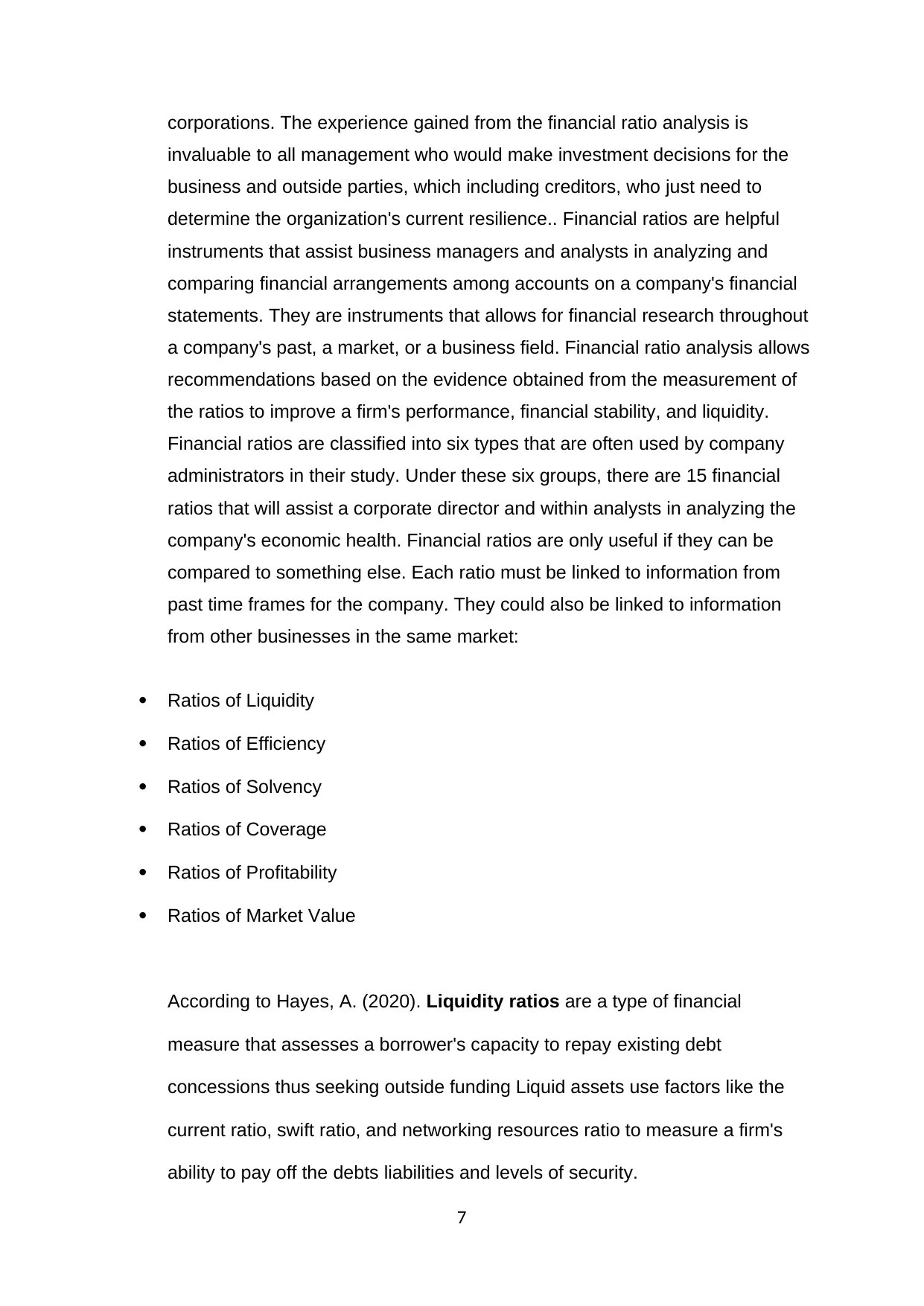
corporations. The experience gained from the financial ratio analysis is
invaluable to all management who would make investment decisions for the
business and outside parties, which including creditors, who just need to
determine the organization's current resilience.. Financial ratios are helpful
instruments that assist business managers and analysts in analyzing and
comparing financial arrangements among accounts on a company's financial
statements. They are instruments that allows for financial research throughout
a company's past, a market, or a business field. Financial ratio analysis allows
recommendations based on the evidence obtained from the measurement of
the ratios to improve a firm's performance, financial stability, and liquidity.
Financial ratios are classified into six types that are often used by company
administrators in their study. Under these six groups, there are 15 financial
ratios that will assist a corporate director and within analysts in analyzing the
company's economic health. Financial ratios are only useful if they can be
compared to something else. Each ratio must be linked to information from
past time frames for the company. They could also be linked to information
from other businesses in the same market:
Ratios of Liquidity
Ratios of Efficiency
Ratios of Solvency
Ratios of Coverage
Ratios of Profitability
Ratios of Market Value
According to Hayes, A. (2020). Liquidity ratios are a type of financial
measure that assesses a borrower's capacity to repay existing debt
concessions thus seeking outside funding Liquid assets use factors like the
current ratio, swift ratio, and networking resources ratio to measure a firm's
ability to pay off the debts liabilities and levels of security.
7
invaluable to all management who would make investment decisions for the
business and outside parties, which including creditors, who just need to
determine the organization's current resilience.. Financial ratios are helpful
instruments that assist business managers and analysts in analyzing and
comparing financial arrangements among accounts on a company's financial
statements. They are instruments that allows for financial research throughout
a company's past, a market, or a business field. Financial ratio analysis allows
recommendations based on the evidence obtained from the measurement of
the ratios to improve a firm's performance, financial stability, and liquidity.
Financial ratios are classified into six types that are often used by company
administrators in their study. Under these six groups, there are 15 financial
ratios that will assist a corporate director and within analysts in analyzing the
company's economic health. Financial ratios are only useful if they can be
compared to something else. Each ratio must be linked to information from
past time frames for the company. They could also be linked to information
from other businesses in the same market:
Ratios of Liquidity
Ratios of Efficiency
Ratios of Solvency
Ratios of Coverage
Ratios of Profitability
Ratios of Market Value
According to Hayes, A. (2020). Liquidity ratios are a type of financial
measure that assesses a borrower's capacity to repay existing debt
concessions thus seeking outside funding Liquid assets use factors like the
current ratio, swift ratio, and networking resources ratio to measure a firm's
ability to pay off the debts liabilities and levels of security.
7
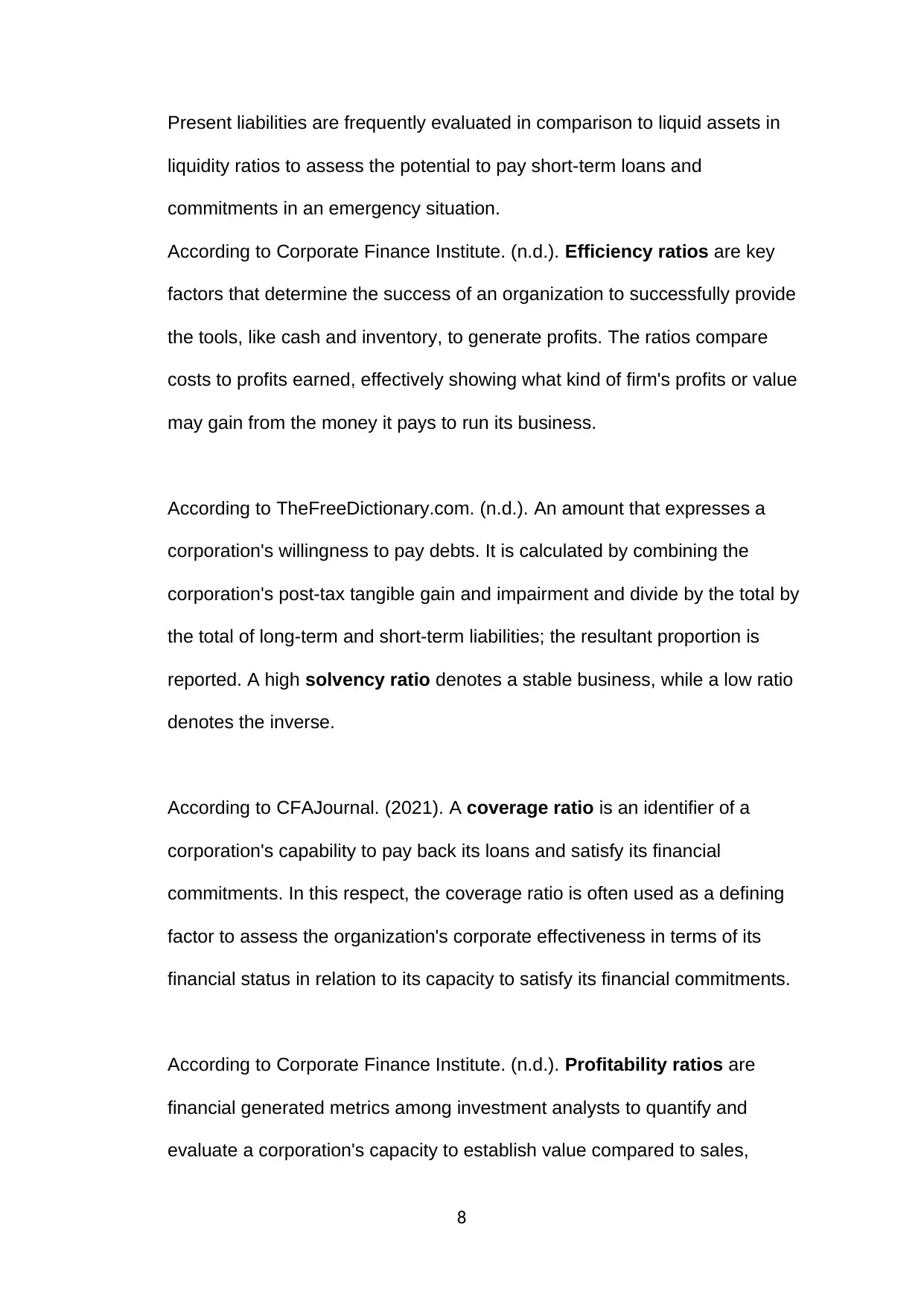
Present liabilities are frequently evaluated in comparison to liquid assets in
liquidity ratios to assess the potential to pay short-term loans and
commitments in an emergency situation.
According to Corporate Finance Institute. (n.d.). Efficiency ratios are key
factors that determine the success of an organization to successfully provide
the tools, like cash and inventory, to generate profits. The ratios compare
costs to profits earned, effectively showing what kind of firm's profits or value
may gain from the money it pays to run its business.
According to TheFreeDictionary.com. (n.d.). An amount that expresses a
corporation's willingness to pay debts. It is calculated by combining the
corporation's post-tax tangible gain and impairment and divide by the total by
the total of long-term and short-term liabilities; the resultant proportion is
reported. A high solvency ratio denotes a stable business, while a low ratio
denotes the inverse.
According to CFAJournal. (2021). A coverage ratio is an identifier of a
corporation's capability to pay back its loans and satisfy its financial
commitments. In this respect, the coverage ratio is often used as a defining
factor to assess the organization's corporate effectiveness in terms of its
financial status in relation to its capacity to satisfy its financial commitments.
According to Corporate Finance Institute. (n.d.). Profitability ratios are
financial generated metrics among investment analysts to quantify and
evaluate a corporation's capacity to establish value compared to sales,
8
liquidity ratios to assess the potential to pay short-term loans and
commitments in an emergency situation.
According to Corporate Finance Institute. (n.d.). Efficiency ratios are key
factors that determine the success of an organization to successfully provide
the tools, like cash and inventory, to generate profits. The ratios compare
costs to profits earned, effectively showing what kind of firm's profits or value
may gain from the money it pays to run its business.
According to TheFreeDictionary.com. (n.d.). An amount that expresses a
corporation's willingness to pay debts. It is calculated by combining the
corporation's post-tax tangible gain and impairment and divide by the total by
the total of long-term and short-term liabilities; the resultant proportion is
reported. A high solvency ratio denotes a stable business, while a low ratio
denotes the inverse.
According to CFAJournal. (2021). A coverage ratio is an identifier of a
corporation's capability to pay back its loans and satisfy its financial
commitments. In this respect, the coverage ratio is often used as a defining
factor to assess the organization's corporate effectiveness in terms of its
financial status in relation to its capacity to satisfy its financial commitments.
According to Corporate Finance Institute. (n.d.). Profitability ratios are
financial generated metrics among investment analysts to quantify and
evaluate a corporation's capacity to establish value compared to sales,
8
⊘ This is a preview!⊘
Do you want full access?
Subscribe today to unlock all pages.

Trusted by 1+ million students worldwide
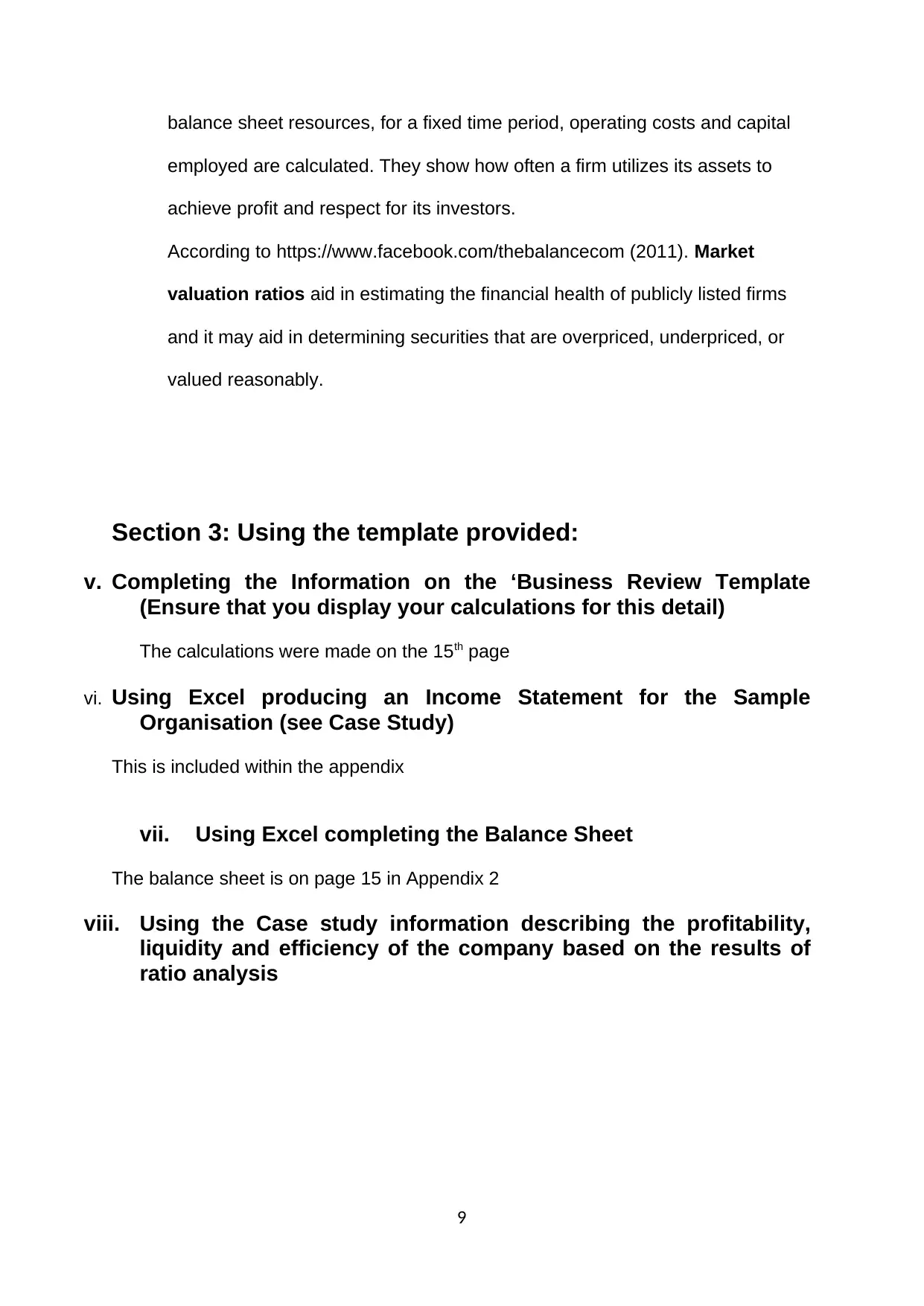
balance sheet resources, for a fixed time period, operating costs and capital
employed are calculated. They show how often a firm utilizes its assets to
achieve profit and respect for its investors.
According to https://www.facebook.com/thebalancecom (2011). Market
valuation ratios aid in estimating the financial health of publicly listed firms
and it may aid in determining securities that are overpriced, underpriced, or
valued reasonably.
Section 3: Using the template provided:
v. Completing the Information on the ‘Business Review Template
(Ensure that you display your calculations for this detail)
The calculations were made on the 15th page
vi. Using Excel producing an Income Statement for the Sample
Organisation (see Case Study)
This is included within the appendix
vii. Using Excel completing the Balance Sheet
The balance sheet is on page 15 in Appendix 2
viii. Using the Case study information describing the profitability,
liquidity and efficiency of the company based on the results of
ratio analysis
9
employed are calculated. They show how often a firm utilizes its assets to
achieve profit and respect for its investors.
According to https://www.facebook.com/thebalancecom (2011). Market
valuation ratios aid in estimating the financial health of publicly listed firms
and it may aid in determining securities that are overpriced, underpriced, or
valued reasonably.
Section 3: Using the template provided:
v. Completing the Information on the ‘Business Review Template
(Ensure that you display your calculations for this detail)
The calculations were made on the 15th page
vi. Using Excel producing an Income Statement for the Sample
Organisation (see Case Study)
This is included within the appendix
vii. Using Excel completing the Balance Sheet
The balance sheet is on page 15 in Appendix 2
viii. Using the Case study information describing the profitability,
liquidity and efficiency of the company based on the results of
ratio analysis
9
Paraphrase This Document
Need a fresh take? Get an instant paraphrase of this document with our AI Paraphraser
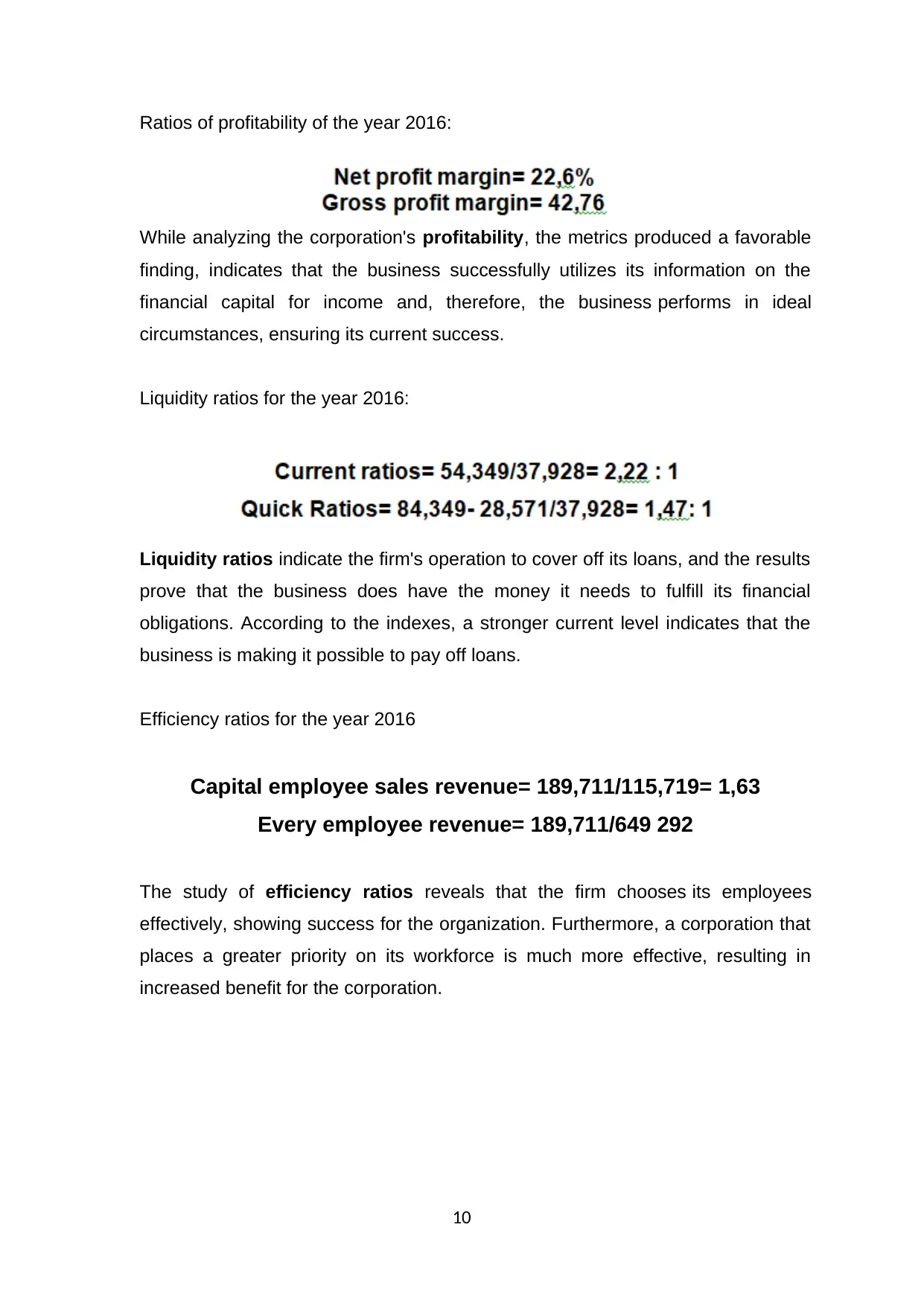
Ratios of profitability of the year 2016:
While analyzing the corporation's profitability, the metrics produced a favorable
finding, indicates that the business successfully utilizes its information on the
financial capital for income and, therefore, the business performs in ideal
circumstances, ensuring its current success.
Liquidity ratios for the year 2016:
Liquidity ratios indicate the firm's operation to cover off its loans, and the results
prove that the business does have the money it needs to fulfill its financial
obligations. According to the indexes, a stronger current level indicates that the
business is making it possible to pay off loans.
Efficiency ratios for the year 2016
Capital employee sales revenue= 189,711/115,719= 1,63
Every employee revenue= 189,711/649 292
The study of efficiency ratios reveals that the firm chooses its employees
effectively, showing success for the organization. Furthermore, a corporation that
places a greater priority on its workforce is much more effective, resulting in
increased benefit for the corporation.
10
While analyzing the corporation's profitability, the metrics produced a favorable
finding, indicates that the business successfully utilizes its information on the
financial capital for income and, therefore, the business performs in ideal
circumstances, ensuring its current success.
Liquidity ratios for the year 2016:
Liquidity ratios indicate the firm's operation to cover off its loans, and the results
prove that the business does have the money it needs to fulfill its financial
obligations. According to the indexes, a stronger current level indicates that the
business is making it possible to pay off loans.
Efficiency ratios for the year 2016
Capital employee sales revenue= 189,711/115,719= 1,63
Every employee revenue= 189,711/649 292
The study of efficiency ratios reveals that the firm chooses its employees
effectively, showing success for the organization. Furthermore, a corporation that
places a greater priority on its workforce is much more effective, resulting in
increased benefit for the corporation.
10
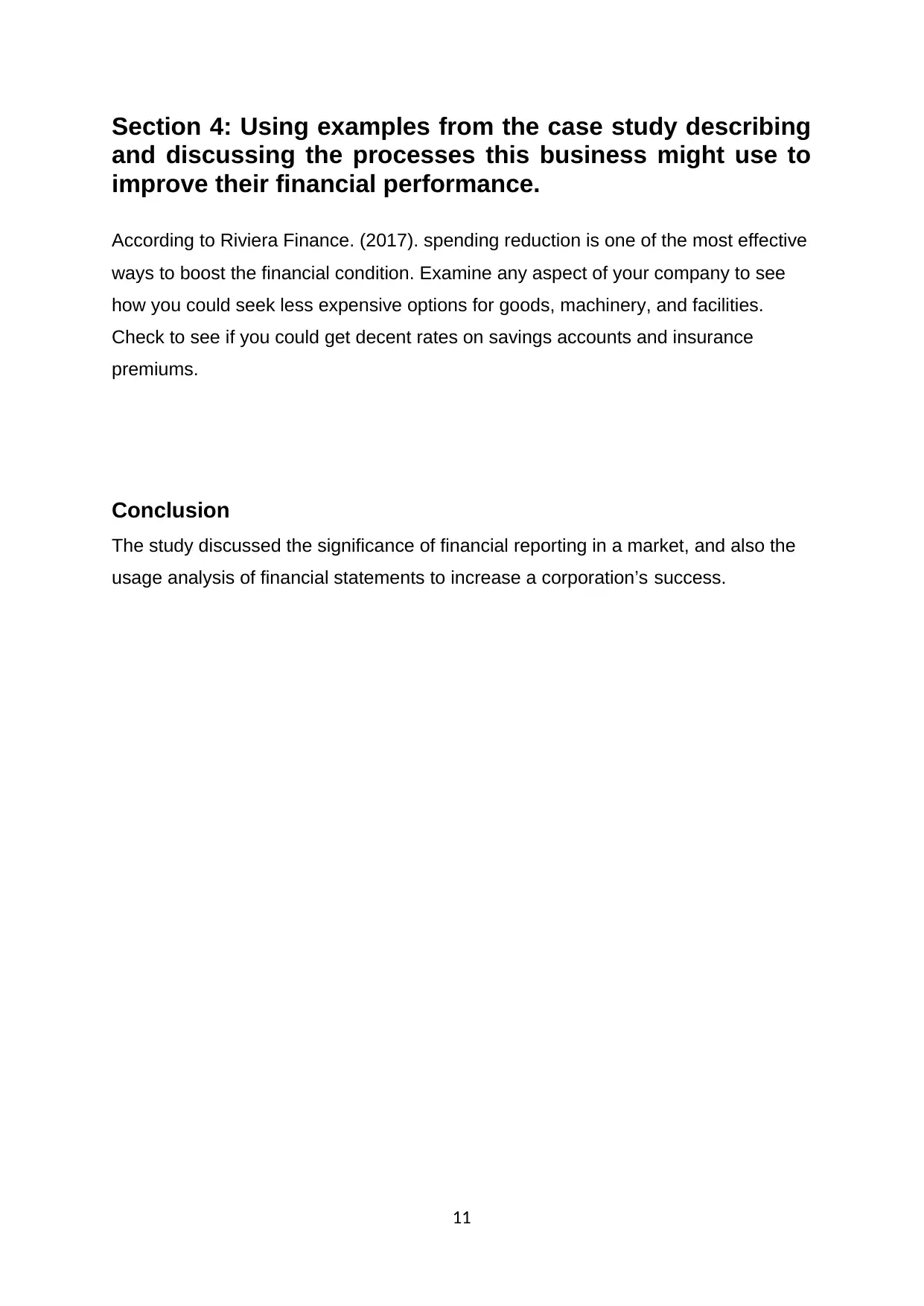
Section 4: Using examples from the case study describing
and discussing the processes this business might use to
improve their financial performance.
According to Riviera Finance. (2017). spending reduction is one of the most effective
ways to boost the financial condition. Examine any aspect of your company to see
how you could seek less expensive options for goods, machinery, and facilities.
Check to see if you could get decent rates on savings accounts and insurance
premiums.
Conclusion
The study discussed the significance of financial reporting in a market, and also the
usage analysis of financial statements to increase a corporation’s success.
11
and discussing the processes this business might use to
improve their financial performance.
According to Riviera Finance. (2017). spending reduction is one of the most effective
ways to boost the financial condition. Examine any aspect of your company to see
how you could seek less expensive options for goods, machinery, and facilities.
Check to see if you could get decent rates on savings accounts and insurance
premiums.
Conclusion
The study discussed the significance of financial reporting in a market, and also the
usage analysis of financial statements to increase a corporation’s success.
11
⊘ This is a preview!⊘
Do you want full access?
Subscribe today to unlock all pages.

Trusted by 1+ million students worldwide
1 out of 19
Related Documents
Your All-in-One AI-Powered Toolkit for Academic Success.
+13062052269
info@desklib.com
Available 24*7 on WhatsApp / Email
![[object Object]](/_next/static/media/star-bottom.7253800d.svg)
Unlock your academic potential
Copyright © 2020–2025 A2Z Services. All Rights Reserved. Developed and managed by ZUCOL.


